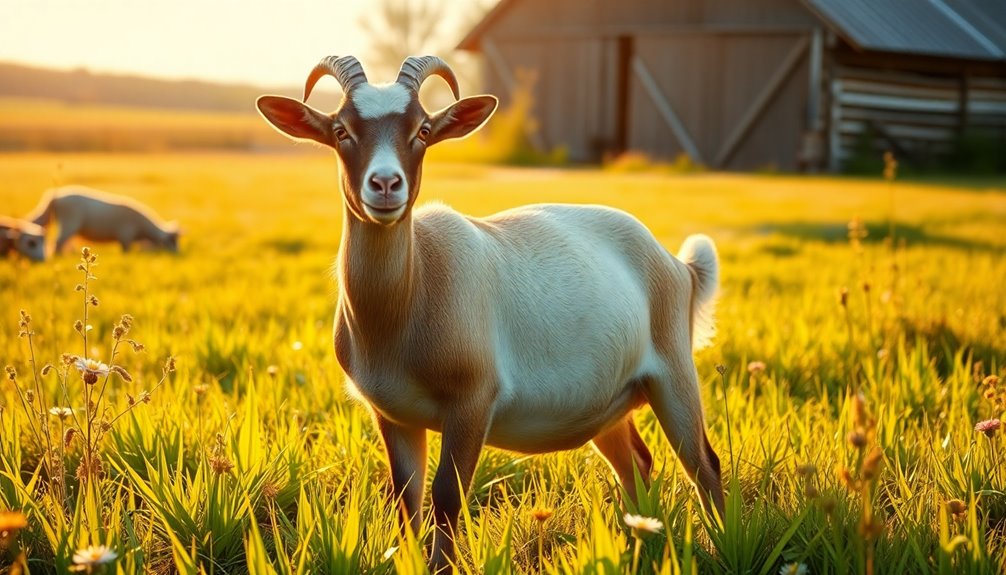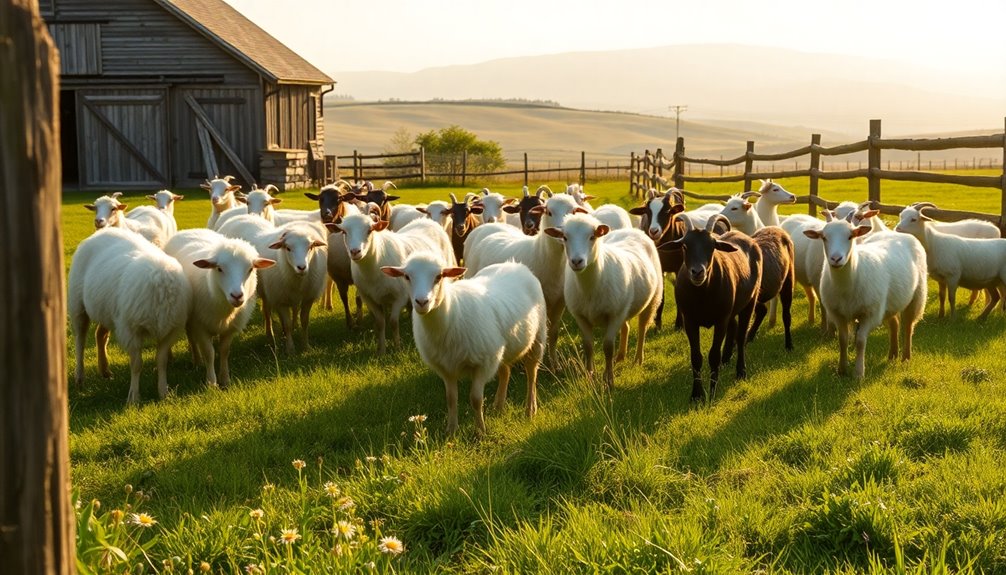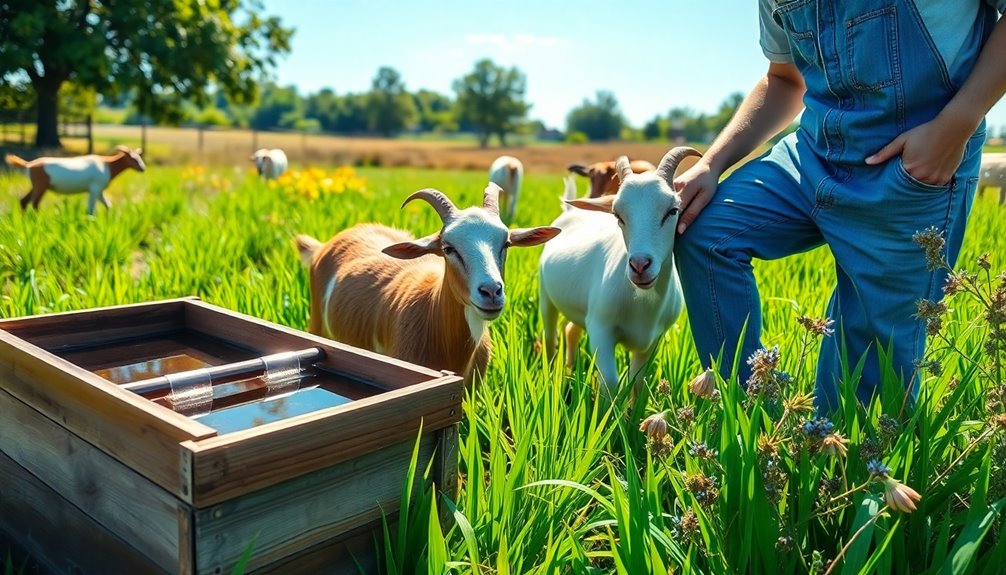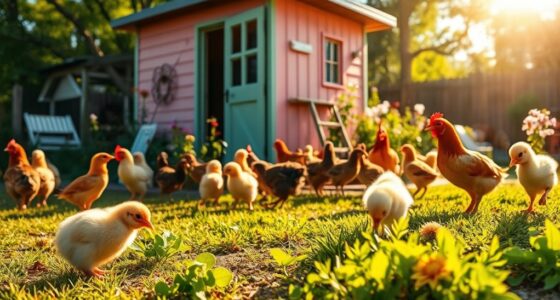When caring for a pregnant goat, watch for signs like increased belly size, udder development, and a greater appetite. The gestation lasts about 150 days, so mark the breeding date to estimate the due date. As the birth approaches, you'll notice restlessness and nesting behavior. During delivery, make certain she's calm and monitor for any complications, like incorrect positions. After birth, support her with warm molasses water and encourage her to eat the placenta for recovery. Staying informed about her needs can make the process smoother, and there's plenty more you can learn to prepare for this exciting time.
Key Takeaways
- Look for signs of pregnancy, such as increased belly size, udder development, and a rise in appetite.
- Monitor the doe for signs of labor, including restlessness, nesting behavior, and heavy breathing.
- During delivery, ensure the correct position with front hooves and head emerging first to avoid complications.
- Post-birth, provide hydration with warm molasses water and encourage the doe to eat her placenta for recovery.
- Allow the doe 4-5 months to recover before considering rebreeding, and confirm pregnancy through blood tests or ultrasounds.
Understanding Goat Pregnancy
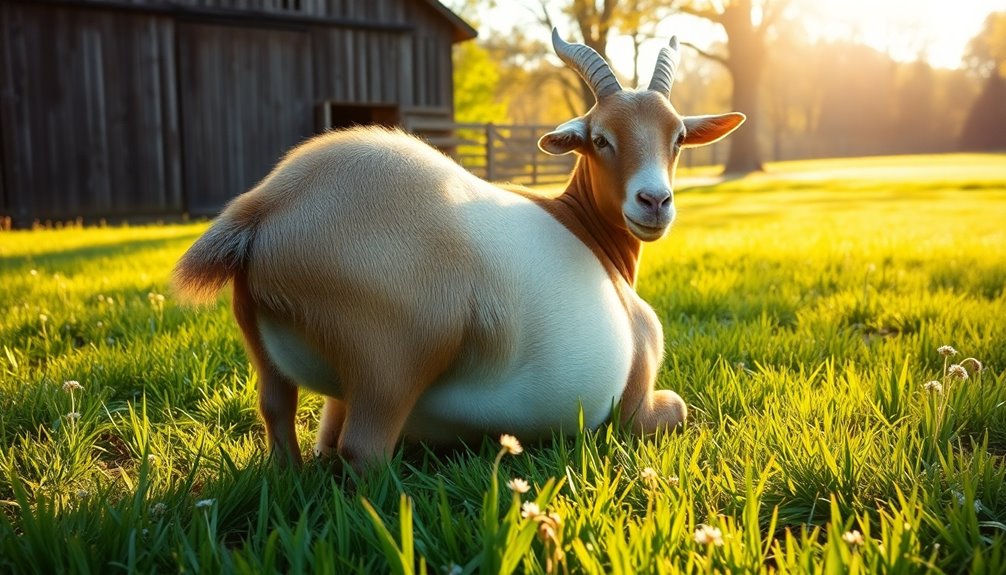
Understanding goat pregnancy is vital for any goat owner aiming to guarantee the health of both the doe and her kids. Goat gestation lasts approximately 150 days, so knowing the breeding date helps you calculate the due date effectively.
Keep an eye on signs of pregnancy, like increased belly size and udder development, which usually appears around six weeks post-breeding. You might also notice behavioral changes; does often seek solitude or start nesting as they prepare for motherhood.
Proper nutrition is important during this time. A balanced diet with increased caloric intake, especially in the late stages of gestation, will help the doe stay healthy and support her growing kids.
It's also important to monitor fetal movement, which you can typically feel around 120 days into the pregnancy. Visible kicks against the doe's side can be an exciting sign that everything's progressing well.
If you want confirmation of pregnancy, consider using blood tests or ultrasounds to verify your doe is on track. By being vigilant about these care tips, you'll be ready to provide the best environment for your pregnant doe and her future kids.
Signs of Pregnancy
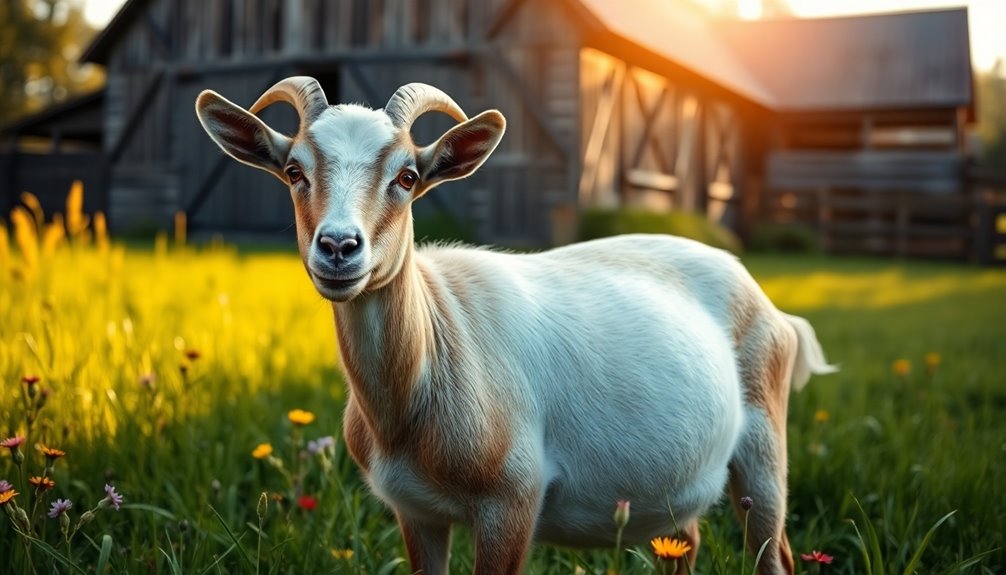
When you're monitoring a pregnant doe, you'll notice several signs indicating her condition.
Look for physical changes like udder development and a growing belly, along with behavioral shifts such as increased appetite and a desire for solitude.
Additionally, you might feel fetal movement around the 120-day mark, confirming those little ones are growing inside her.
Physical Changes Observed
Pregnant does undergo several physical changes that signal their condition and the approaching delivery. As a goat owner, it's important to recognize these signs to guarantee proper pregnant goat care.
Here are some key physical changes you should observe:
- Increased Belly Size: You'll notice a noticeable growth around two weeks post-breeding as the fetus develops.
- Udder Development: Often called "bagging up," this process usually starts about six weeks after breeding, indicating that kidding season is near.
- Teat Lengthening: Experienced does may show this sign earlier than first-time mothers, preparing for the arrival of kids.
- Caps on Teats: These can form to provide bacterial protection before birth, showcasing a significant physiological change.
Keep an eye on these physical changes in your pregnant goat. They're key indicators of her nearing delivery.
Along with these changes, you might also see some behavioral changes, like increased appetite and nesting behavior, as her body prepares for the upcoming birth.
Recognizing these signs will help you provide the best care for your doe during this important time.
Behavioral Indicators
Typically, you'll notice several behavioral indicators that signal your doe's pregnancy. These changes can aid you in providing proper pregnant goat care. Here are some key signs of pregnancy you should watch for:
| Behavioral Change | Description | Timing |
|---|---|---|
| Increased Appetite | Your doe may eat more than usual. | Early to late pregnancy |
| Solitude Seeking | She might prefer to be alone or isolated. | Throughout pregnancy |
| Nesting Behavior | Look for signs of her preparing a nesting area. | Approaching labor |
| Frequent Urination | Increased trips to urinate are common. | Late pregnancy |
| Personality Shifts | Friendly does may become standoffish. | Near due date |
These behavioral changes, such as udder development and increased appetite, often indicate that delivery is imminent. Experienced does might show udder development earlier compared to first-timers. As the due date approaches, be alert for frequent urination and potential personality shifts in your doe. Recognizing these signs of pregnancy can guarantee you're ready for the exciting arrival of new kids!
Fetal Movement Detection
Detecting fetal movement in your pregnant doe is an important part of ensuring a healthy pregnancy. You can typically feel these movements around 120 days into the gestation period, which lasts about 150 days.
Here are some key points to keep in mind:
- Feel for Kicks: By placing your hand on the doe's belly, you might feel the signs of kicking, especially if she's carrying multiple kids.
- Watch for Bulges: A slight bulge or ripple on the side of her abdomen can indicate active fetal development.
- Monitor Activity: Regularly monitoring activity is essential; a decrease or absence of fetal movement can signal potential health concerns that may require veterinary attention.
- Engage in Handling Observation: Regular handling helps you recognize normal movement patterns versus abnormal ones, making it easier to detect any issues.
Being attuned to these signs of fetal movement allows you to provide better care for your pregnant doe.
Early detection of any changes in her activity can make all the difference in ensuring a successful pregnancy and healthy kids.
Stages of Labor
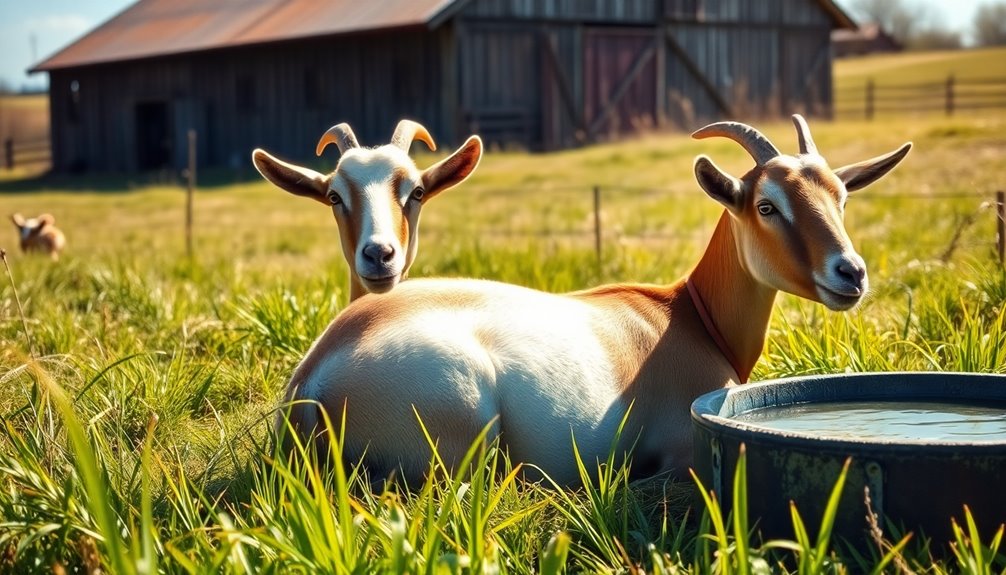
Understanding the stages of goat labor is crucial for any goat owner. The process begins with the preparation stage, where you'll notice your doe exhibiting signs of restlessness and nesting behavior. This stage indicates that kidding is imminent.
As labor progresses, look for signs of active labor, such as abdominal waves and heavy breathing.
Next comes the delivery stage, which can last anywhere from 1 to 12 hours. During this critical phase, you'll see visible signs like the appearance of the amniotic membrane and the presentation of two hooves and a nose, signaling that the kid is approaching birth.
Once delivery is complete, the afterbirth stage follows. The placenta should be expelled within a few hours, which is essential for the doe's recovery.
Close monitoring is necessary throughout all stages of labor, as each doe may experience variability in labor length and style. Be vigilant for potential complications during this time.
With the right knowledge and preparedness, you can support your doe through each stage of labor, ensuring a successful kidding experience.
Labor Timeline
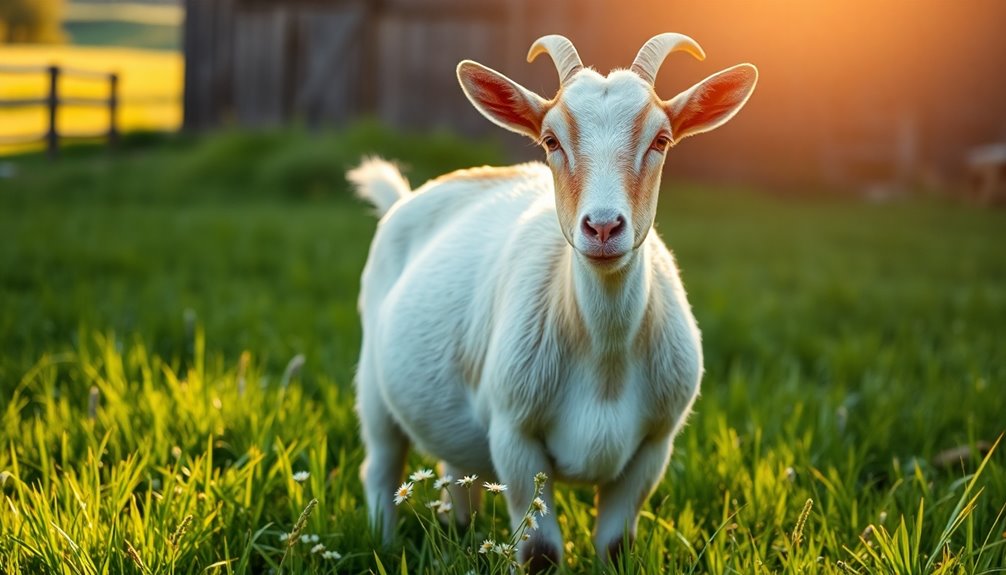
The labor timeline for a pregnant goat is essential for guaranteeing a smooth kidding process. Understanding what to expect can help you provide the best care during this critical time. Here are four key points to remember:
- Signs of Labor: Early indications include abdominal waves, teeth grinding, and heavy breathing as she approaches active labor.
- Kidding Duration: The entire process can last anywhere from 1 to 12 hours, so be prepared for variability in each doe.
- Delivery Indicators: Look for the appearance of the amniotic membrane, along with the visibility of two hooves and a nose, signaling that delivery is imminent.
- Final Stages of Labor: In these stages, you'll notice the softening of the pin bones, vulva swelling, and changes in discharge.
Be sure you're monitoring closely during this time. Each doe may experience different lengths and styles of labor, so keep an eye out for any signs of distress or complications.
Recognizing these indicators will help you support her through the active labor and guarantee a safe delivery for both the mother and the kids.
Birth Positions
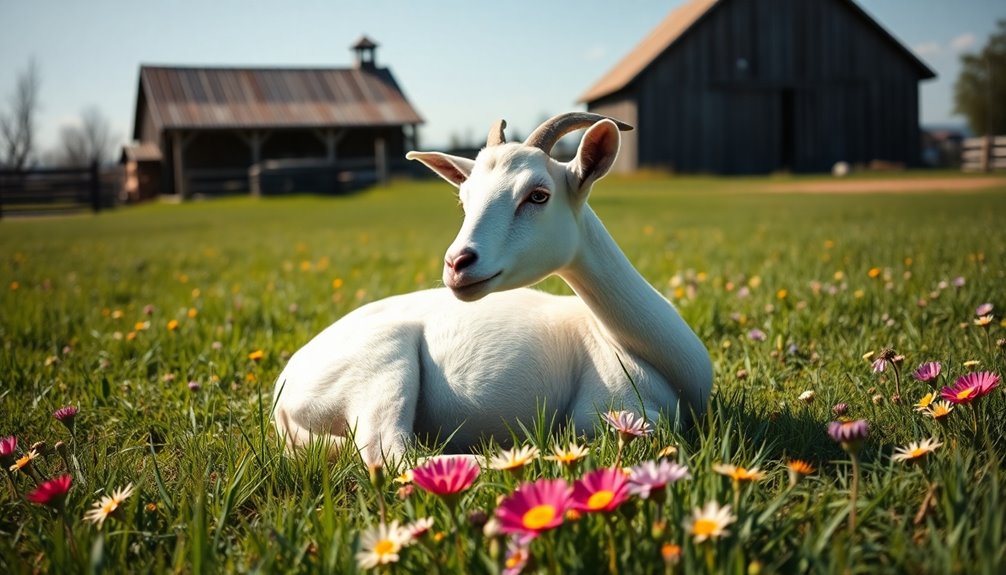
When your goat goes into labor, understanding the common delivery positions is essential for a smooth process.
You should be aware of potential complications, like a breach presentation or the head being back, which can pose risks to both the doe and her kids.
If you notice any signs of distress or if the hooves and nose aren't visible, it's time to assist with the delivery to guarantee everything goes safely.
Common Delivery Positions
Positioning during delivery is vital for a successful birth in goats. Understanding common goat delivery positions can help you provide better pregnant goat care and guarantee a smoother kids delivery. Here are some key positions to watch for:
- Normal Presentation: The ideal position is when the front feet and head emerge first, facilitating an easier birth.
- Backwards Head: If the head is back, it may signal complications during birth that need your intervention.
- Breech Position: Should the back end present first, consider gentle repositioning using clean surgical gloves and lubricant.
- Simultaneous Delivery: If multiple kids are being delivered at once, monitor closely for signs of distress.
While goats generally handle goat labor without help, it's important to keep monitoring goats throughout the process.
If the head isn't visible after the hooves have emerged, check the kid's position for potential complications.
Being prepared to assist can make a significant difference in cases where delivery doesn't go as planned.
Always stay calm and ready to intervene if necessary to safeguard the health of both the mother and her kids.
Complications of Delivery
Complications can arise during goat delivery due to various birth positions. You'll want to keep an eye on the amniotic membrane, as its appearance indicates that labor is progressing.
Ideally, you should see two hooves and a nose, signaling that the kid is in the correct delivery position. If the hooves appear but the head isn't visible, and your doe shows signs of distress, checking the kid's position becomes vital for a safe delivery.
Some dangerous delivery positions, like having the head back or multiple kids coming at once, can complicate things considerably. Each doe may experience different lengths and styles of labor, so understanding the variability in delivery positions is important.
Should you notice an incorrect position, you may need to offer assistance. Remember to use clean surgical gloves and lubricant to gently maneuver the kid into the proper position.
Monitoring your pregnant goat closely during this time can make a considerable difference. By recognizing signs of distress and acting swiftly, you can help guarantee a smoother and safer delivery for both the doe and her kids.
Assistance During Birth
Successful delivery of kids often hinges on recognizing the right birth positions and knowing when to step in. Here are four key points to keep in mind during assistance:
- Monitor the Doe: Look for signs of active labor, like arching of the back or pawing at the ground. This helps you anticipate when assistance during birth might be necessary.
- Know Delivery Positions: The safest position for kids to be born is with the two front hooves and nose coming out first. Be cautious of positions where the head is back, as these can be dangerous.
- Check for Distress: If the doe shows signs of distress and the head isn't visible after the hooves appear, you'll need to gently check the kid's position.
- Prepare for Intervention: If assistance is required, use clean surgical gloves and lubricant to help maneuver the kid into a proper position for delivery.
Post-Birth Care
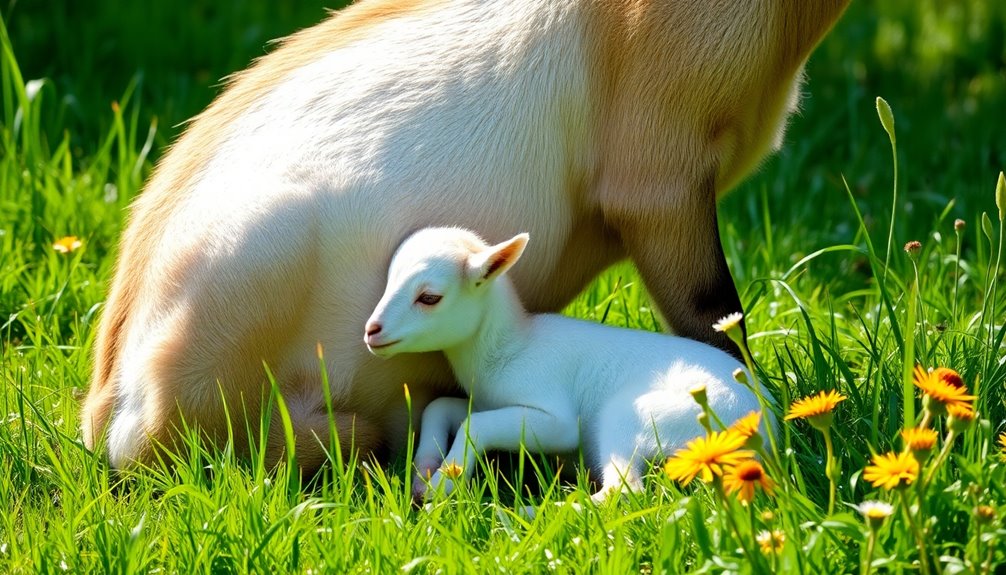
What should you prioritize in post-birth care for your doe? First, give her time to rest and recover. Make sure she's access to warm molasses water, which provides energy and hydration.
It's also essential to offer the placenta for her to consume, as this instinctual behavior helps with her recovery and provides important nutrients.
For the newborn kids, dry them thoroughly, especially if it's cold, to prevent hypothermia and encourage bonding with their mother. You should also tie the umbilical cord about 3/4 inch from each kid's belly and dip it in iodine to prevent infection.
Monitor the kids closely to guarantee they attempt to stand and nurse within the first hour after birth. Colostrum intake is critical for their immunity and overall health, so be ready to assist if needed.
Rebreeding Considerations
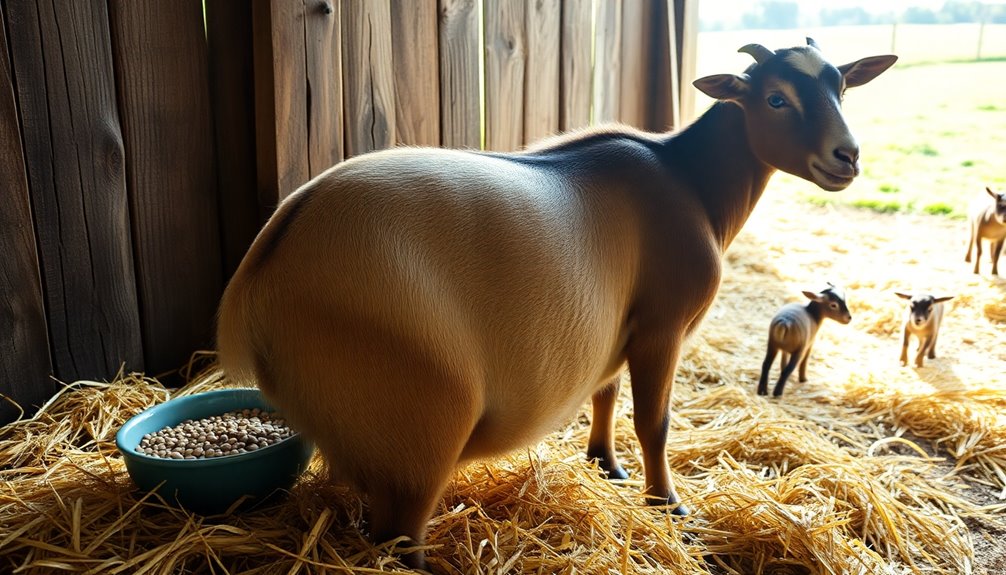
When considering rebreeding your doe, it's crucial to prioritize her health and recovery first. Goats can become pregnant as soon as two weeks after giving birth, but allowing at least 4-5 months of rest is generally recommended.
Here are some key rebreeding considerations to keep in mind:
- Health Assessment: Evaluate your doe's age, body condition, and recent kidding experience to determine her readiness for rebreeding.
- Recovery Period: Make sure she's adequate time to bond with her kids during the weaning period, which typically occurs 2-3 months post-birth.
- Nutritional Support: Provide high-quality hay, free-choice minerals, and a balanced diet to help her recover and prepare for another pregnancy.
- Pregnancy Confirmation: After breeding, confirm her pregnancy with a blood test at around 30 days or an ultrasound at 40 days for better management of her care.
Nutritional Needs
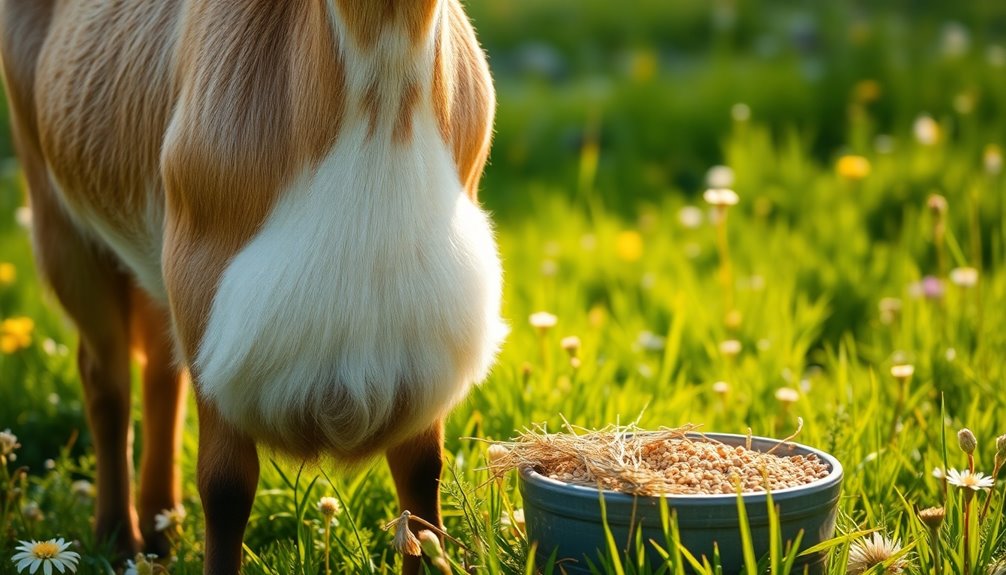
Meeting the nutritional needs of pregnant does is vital for their health and the development of their kids. To guarantee ideal growth, provide a balanced diet that increases caloric intake, especially during the last trimester. High-quality hay or alfalfa should be the main component of their diet, along with free-choice minerals to meet their nutritional needs.
If you have thin does, gradually introduce grain into their diet, but do this cautiously to prevent digestive issues like bloat. Remember, hydration is important; pregnant goats may need access to clean water and up to four gallons daily, particularly in warmer weather.
Keep an eye out for signs of ketosis and hypocalcemia, as these conditions can pose serious risks. Dietary adjustments may be necessary to guarantee adequate mineral intake and prevent health complications.
Regularly monitor their condition and be prepared to make changes to their diet as needed to support their health and fetal development. By prioritizing their nutritional needs, you're setting the stage for a successful kidding season and healthy kids.
Preparing for Kidding
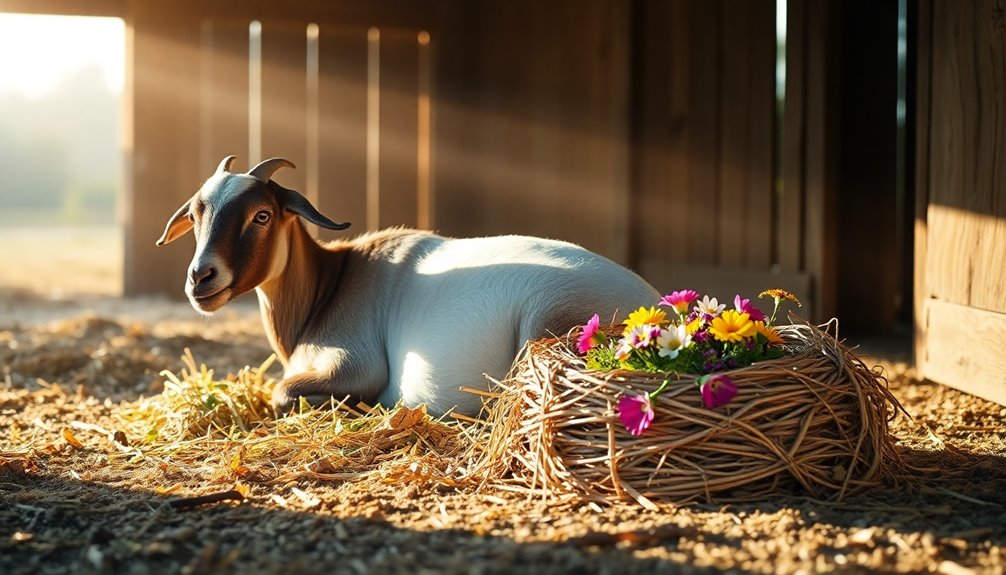
As your doe approaches her due date, it's important to prepare for kidding to guarantee a smooth birthing process.
Start getting ready at least two weeks prior by closely monitoring your doe for any physical changes and behavioral signs of labor.
Here are four key steps to follow:
- Clean the Kidding Stall: Create a comfortable kidding stall with fresh straw bedding to provide a safe environment for the doe during the birthing process.
- Assemble a Kidding Kit: Prepare a kidding kit that includes gloves, iodine for the umbilical cord, scissors for cutting, and emergency veterinarian contact information.
- Stock Colostrum: Keep powdered or frozen colostrum on hand, as it's crucial for the newborn kids' immune health in case the doe has difficulty nursing.
- Monitor Your Doe: Pay attention to signs of labor, like restlessness, nesting behavior, swelling of the vulva, and discharge.
Frequently Asked Questions
How Do You Know When a Goat Is Close to Giving Birth?
You'll know a goat is close to giving birth by observing changes in her behavior and body.
Look for increased restlessness, nesting behavior, and her seeking solitude.
Watch for physical signs like udder swelling, softening pin bones, and vulva swelling.
Fetal movements may become more noticeable, and you might see discharge or a drop in appetite.
Keep an eye out for active labor signs, like back arching and pawing at the ground, within 24 hours.
How to Take Care of a Pregnant Goat?
To take care of a pregnant goat, guarantee she's access to high-quality hay or alfalfa and free-choice minerals.
Keep her environment quiet and comfortable to reduce stress.
Monitor her for physical changes, like udder development and a growing belly.
Limit stress during the early weeks post-breeding, and prepare a clean kidding area with essential supplies.
This way, you'll support her health and the well-being of her kids.
What Are the Early Signs of Pregnancy Toxemia in Goats?
You'd think a goat would just munch happily, but early signs of pregnancy toxemia can be quite the opposite.
You might notice your goat's lethargy and lack of appetite, which isn't normal. She may isolate herself, displaying restlessness or nervousness.
As the condition worsens, you could see staggering or tremors.
Recognizing these signs early is essential; otherwise, it could lead to serious complications for both her and her kids.
How Can You Tell How Far Along a Goat Is in Pregnancy?
To tell how far along a goat is in pregnancy, you can count the days from the breeding date, noting that the average gestation is about 150 days.
Around 120 days in, you might feel fetal movements.
Look for physical changes, like udder development or longer teats, which typically appear about six weeks before kidding.
Also, keep an eye on her appetite and body condition for additional clues about her stage.
Conclusion
To summarize, caring for a pregnant goat can be a rewarding experience. Did you know that goats typically give birth to twins or triplets about 50% of the time? Imagine the joy of seeing those little hooves emerge, bringing life and energy to your farm. By understanding the signs of pregnancy and preparing adequately, you'll guarantee a smooth process for both you and your goat. Embrace the journey, and you'll create lasting memories together.

